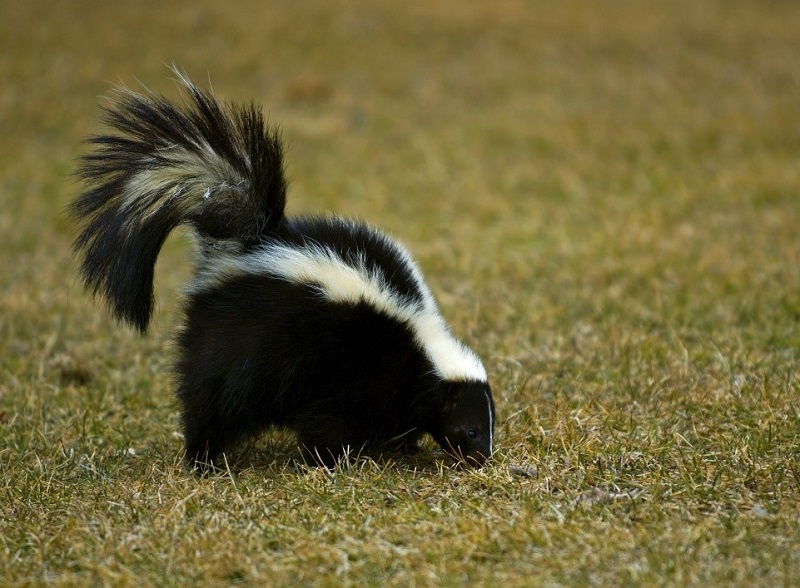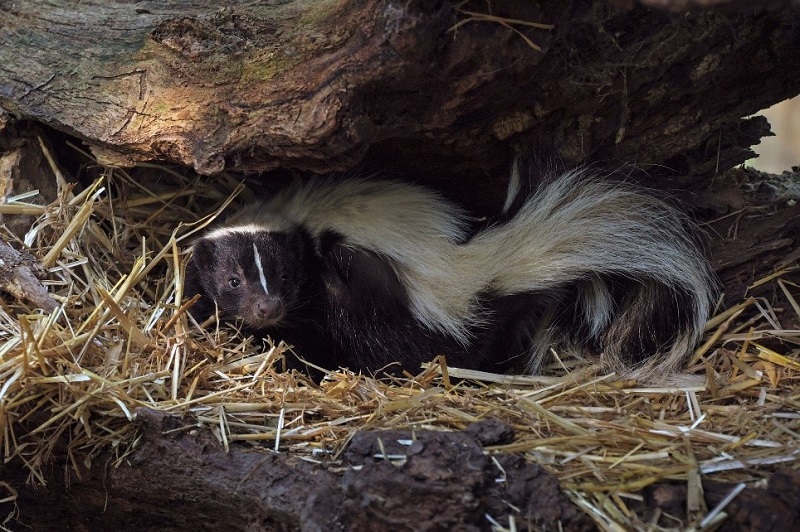10 Places Skunks Live & Hide

Knowing Where Skunks Live is Half of the Battle
Sure, skunks are stinky. But there are likely some of them sleeping a lot closer to you than you think each night, just outside or not far from your home.
But where?
Typically speaking, skunks live in dens they dig with their front claws. They can also make abandoned fox holes, hollowed-out logs, or wood piles a new home for their family. If you look in your yard and see holes, it could be a skunk den.
As long as food, water, and shelter are available for the rodent, skunks can survive in most areas.
Now that skunk mating season is upon us, homeowners need to ensure their property isn’t enticing to the critter, and take the right steps to ensure they don’t move in.

Where do Skunks Hide Around Your Home?
Knowing where skunks hide, especially around your property, is an important part of eliminate problems before they start when it comes to keeping them away from your home.
1. Under Decks
The most common place to find a skunk den is beneath a deck or porch.
This area usually has a high clearance, often with numerous potential entry points. This can make skunk removal both easy and difficult at the same time. The best route to take is a wildlife exclusion system.
Trench-Guard Wildlife Barrier is the underground component of our Cat-Guard Exclusion System which ensures areas surrounding the home are protected from wildlife.
While a lot of home projects fall under the DIY category, skunk removal is not one of them. Pest management professionals have the knowledge and skills to swiftly remove skunks from your property an prevent them from returning.
2. Under Sheds
Low-clearance structures, such as sheds, are difficult to see under. This privacy creates an ideal space for the skunk to burrow and create a den.
Decks and sheds are top choices, especially during the spring time — also known as skunk birthing season. Female skunks will create a new den before giving birth to her kits. The young will then live with the mother until they are weaned — approximately two months.
3. Under Additions of Homes
The best way to deal with this issue is to find the point of entry. If a female skunk has made a den for her kits nearby, they could be looking for a new place to make a den of their own.
Once the skunks have been removed, it is essential to seal up any entry points.
4. In garages
If a garage door is left open, it’s possible that skunks will wander in and make themselves comfortable. Skunks are primarily active at night so leaving the door open and allowing them to wander back out could be a solution to the issue.
However, it’s important to make sure the skunk has not been visiting the garage frequently enough to establish a den, give birth, or access to food (bags of bird seed or dog food, for example). If this is the case, leaving the door open and hoping they leave will not be enough.
5. In Crawl Spaces of Homes
If a skunk has made their way into a crawl space in your home, it can lead to a bigger issue.
If it happens during skunk mating season and a female is pursued by a male that she doesn’t want to mate with, she could spray him to deter his pursuit. A skunk could also spray if they feel trapped in an area. No matter the reason for the spray, the unpleasant smell could then permeate your home.
6. Stacked Wood Piles
Homes that use split wood as a heat source could find skunks living in the stacked wood piles.
Stacks of wood create a great source of shelter for the critter because they are covered on every side while also allowing them to burrow into the dirt to create a deeper den for their kits.

7. Stone Walls
Areas that are typically undisturbed, such as stone walls, can be ideal for skunks. The critter can create a den, burrowing under the heavy stones, that could go unnoticed.
8. Dried Drainage Culvert Pipes
While skunks are typically found living in underground dens, it is possible to find them hiding in a dried drainage pipe, or a culvert.
9. Under Stumps
Homeowners who live in a country setting will likely find that skunks have made a den under a hollow stump or log. The stump can provide a source of protection from the elements, as well as a food source if grubs or insects have made their way inside the wood.
10. Tall Grass
Yards with tall grass around the perimeter can be a potential place for skunks to create a den. The grass provides insulation and camouflage for the hole. The skunk can also find plenty to eat in the dirt surrounding the den.
DIY Skunk Repellent
If you suspect that a skunk is making themselves more comfortable on your property, there are natural ways homeowners can repel the rodent.
Like many animals, skunks cannot stand the smell of citrus fruits. Spreading citrus peels along the perimeter of your yard can act as a deterrent. As the peels begin to dry, it’s important to spread fresh pieces to continue offending their senses.
If any skunks are hiding under the aforementioned areas, like the deck or shed, spraying a homemade mixture of water, cayenne pepper, yellow onion, and jalapeno pepper around the perimeter of the structure can cause them to vacate.
Professional Skunk Removal
If your home has a skunk under the deck, or any area for that matter, it’s important to contact a pest and wildlife management company.
Trapping and removing skunks from the property is a pivotal role in fixing the issue but is not something that should be done by an amateur. Professionals have the knowledge and equipment to safely capture and remove the critter.
“Placing the cage opening in front of the den entrance with an attractive bait is the best way to entice the skunk to leave,” said Paul Dube, A.C.E. of skunk removal for homeowners.
Removing the skunk is only part of the battle, they need to be stopped from making a den under your deck or shed in the future.
Rodent and wildlife exclusion is the easiest way to prevent wildlife from taking over your property. Much like it sounds, it is the process of excluding pests and wildlife from accessing your home.
The easiest way to achieve long-lasting pest and wildlife exclusion is with Catseye’s Cat-Guard Exclusion Systems. Contact our professionals for your free home evaluation and to remove skunks once and for all.






